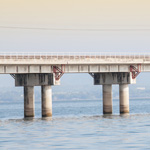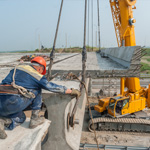
Concrete bridges have been built in North America since 1889, when a single arch concrete bridge spanning 20 ft was built in California. In 2019, over 400,000 concrete bridges were documented in the National Bridge Inventory.
Concrete bridges have many advantages including:

> Adaptability
Concrete Bridges can be formed to match the environment and have been used for large and small spans.

> Resilience
Concrete bridges have proven to be resilient against all types of loads and impact.

> Structural Redundancy
Concrete bridges form redundant load paths, leading to reliable structural performance.

> Long Term Durability
Concrete bridges have proven to be durable, even in harsh environments.

> Low Maintenance
Concrete bridges require little maintenance.

> Rapid Construction
Concrete bridges may be rapidly constructed using local labor.

> Economy
Concrete bridges prove to be economical in initial cost and over the long term.

> Flexibility
Concrete bridges may be formed using a variety of methods and can meet the demands of any load rating or design features.

> Aesthetics
Concrete bridges may include many aesthetic features such as color, shape, texture, design or patents.

> Versatility
Concrete bridges may be used anywhere a crossing is required. They may be reinforced, prestressed, precast, post-tensioned, segmental or cast-in-place to meet the design requirements.

> Constructability
Concrete bridges are rapidly constructed using a variety of construction techniques.
